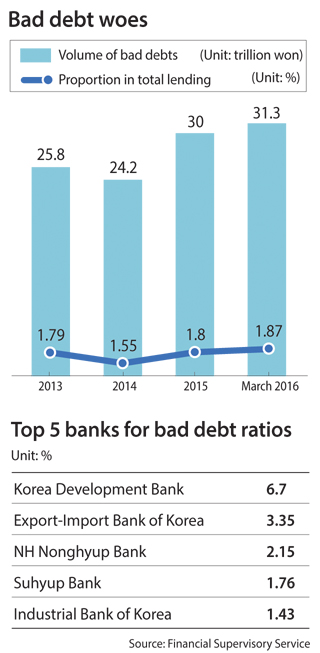Korean banks’ bad debt soars to 15-year high

According to the financial watchdog on Thursday, bad debt volume rose by 4.3 percent, or 1.3 trillion won, in the first three months of the year. It rose by 26.7 percent, or 6.6 trillion won, compared to last March.
The volume is the largest since March 2001, when local banks held bad debt worth 38.1 trillion won.
The bad debt accounted for 1.87 percent of total lending as of March, up 0.31 percentage points compared to last March’s 1.56 percent. This was the highest in five years, since the bad debt ratio reached 2 percent in March 2010 in the wake of the 2009 global financial crisis.
Korea’s bad debt ratio is higher than that of most major economies. The United States recorded 1.54 percent as of the end of 2015, and Japan saw 1.53 percent as of September 2015.
“We’ll keep monitoring the soundness of local banks’ assets, especially loans to troubled sectors, and will order them to become more sound by saving more money in reserves,” said an official from the FSS.
Corporate debt was the main culprit of the steep rise in bad debt, mainly from conglomerates.
Of the total 31.3 trillion won, bad corporate debt accounted for 29.2 trillion won, or 93.3 percent, of the total, while bad debt from households and personal credit cards accounted for only 2.2 trillion won.
The bad debt ratio for Korean companies has kept climbing, from 2.09 percent at the end of 2014 to 2.56 percent in March.
The rise was mainly due to conglomerates, which have seen their bad debt ratio increase sharply from 2.28 percent in 2014 to 3.76 percent last year and 4.07 percent in March.
Meanwhile, the bad debt ratio for small and midsize companies has steadily declined during the same period, from 1.94 percent in 2014 to 1.61 percent in March.
The bad debt ratio among households remained low at 0.36 percent.
By sector, the shipbuilding industry showed the highest bad debt ratios, followed by the shipping and construction industries.
Twelve percent of all loans to local shipbuilders had gone bad, while that figure was 11.43 percent for shippers and 4.27 percent for builders.
The main lenders to the ailing shipbuilding and shipping industries, the two state-run banks, showed the steepest rate of increase and highest bad debt ratios.
Korea Development Bank (KDB) had the most bad debt at 8.6 trillion won as of March, up 17.8 percent within the first three months this year. KDB also saw nearly 6.7 percent of its total loans go bad, up from 5.68 percent last December.
The Export-Import Bank of Korea had 4.2 trillion won in bad debt, up 4.76 percent in the first three months this year. The bank’s bad debt ratio stood at 3.35 percent.
NH Nonghyup Bank had the most bad debt among commercial banks, at 4 trillion won, accounting for 2.15 percent of its total lending.
Other major commercial banks are relatively free from the burden.
Shinhan Bank’s bad debt ratio was 0.86 percent, while KEB Hana recorded 1.24 percent, KB Kookmin 1.08 percent and Woori Bank 1.38 percent.
BY KIM JI-YOON [kim.jiyoon@joongang.co.kr]










with the Korea JoongAng Daily
To write comments, please log in to one of the accounts.
Standards Board Policy (0/250자)